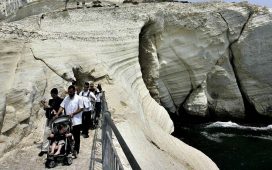“Before the Chandrayaan missions, scientists thought the moon was bone dry. Whereas after Chandrayaan, they discovered the presence of water molecules on the surface, sub-surface and exosphere,” Veeramuthuvel said. There was a resurgence of global interest in lunar exploration post this, he said.
Scientists were also under the assumption that the moon is geologically dead, but the Chandrayaan missions proved that the moon is dynamic and volcanically active, he said.
The Union cabinet recently approved India’s fourth lunar mission Chandrayaan-4 to bring lunar samples to earth.
August 23 is now marked as the National Space Day to celebrate the spirit of science, technology and innovation.
“We thought the moon’s regolith completely absorbs impinging solar wind protons. But after Chandrayaan, we realised 20% of solar wind protons are reflected back to space as energetic neutral hydrogen atoms,” Veeramuthuvel said.
Scientists also thought the moon does not have a magnetic field, but after Chandrayaan, the presence of mini magnetospheres on the moon were revealed, he said.
Before Chandrayaan, the lunar surface was thought to be vulnerable to impacts and that human settlement was not possible. “But now the image of a potential site (buried lava tube) for future human habitability on the moon is being discussed,” Veeramuthuvel said.
“Our previous understanding was that there were no solar flares during the quiet sun period. Now, the detection of large numbers of microflares during the quiet sun period and insights to the coronal heating puzzle are being analysed,” he said.
Previously, scientists thought that the moon is heavily cratered and hence it is difficult to land on the surface. “However, images from Chandrayaan-2 are some of the best and sharpest taken by the orbital high-resolution camera. It gives 25 cm spatial resolution, which is the best available image, globally,” Veeramuthuvel said.
“We have thoroughly characterised the landing sites with less than five metres diameter craters and one to two metre boulders. We also did not have any understanding of the southern high latitude region. There were several unknown aspects. After the successful landing of Chandrayaan-3, we have characterised ground vibration signals, plasma environment, thermal profile and elemental composition at 69 degrees to the South Pole,” he explained.










